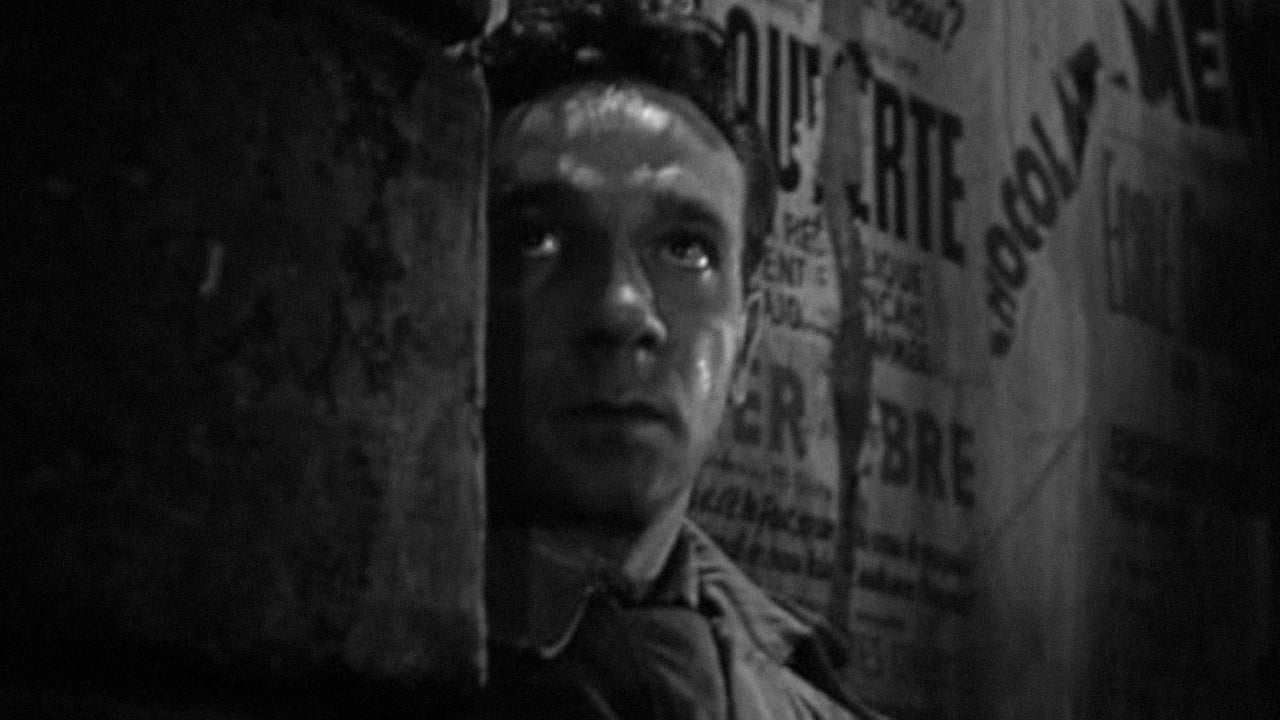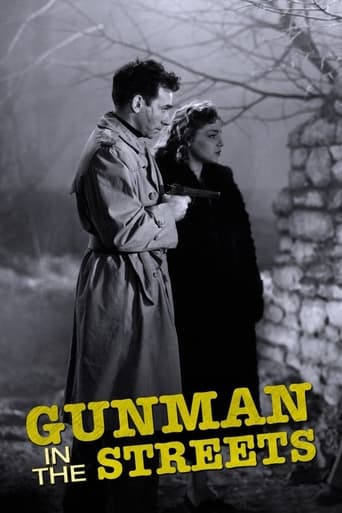BlazeLime
Strong and Moving!
TeenzTen
An action-packed slog
Numerootno
A story that's too fascinating to pass by...
Aneesa Wardle
The story, direction, characters, and writing/dialogue is akin to taking a tranquilizer shot to the neck, but everything else was so well done.
Richard Chatten
Atmospherically shot by the veteran Oscar-winning cameraman Eugen Schüfftan, 'Gunman in the Streets' is the English-language version of a co-production released in France as 'Le Traqué'. The French version is now even more obscure than this, and since it had a different credited director (Borys Lewin, normally an editor) may be substantially different from this one. All those obviously Gallic types speaking English seem a little incongruous and it would be easy to imagine this with subtitles (Dane Clark and Robert Duke were presumably dubbed). Jean-Pierre Melville probably saw 'Le Traqué', and Fernand Gravet's police commissioner, suavely hot on Clark's trail, strongly resembles Paul Meurisse's Commissaire Blot in Le Deuxième Soufflé' (1966).The English-language version bears the name of blacklisted Hollywood veteran Frank Tuttle (before he yielded in 1951 to pressure to name names to the HUAC), which may be why it was never released theatrically in the United States. But it can't have helped that it's so relentlessly sordid, grim and claustrophobic, with a hero unlikeable even by Dane Clark's usual charmless standard.It starts like 'Odd Man Out', with Clark on the run on the streets of Paris with a bullet in his shoulder after shooting his way to freedom. He contacts former girlfriend Simone Signoret, curtly informs her that he needs 300,000 francs pronto to get out of the country, and they hole up in the apartment of a creepy admirer of Signoret's (Michel André) who Clark handles predictably roughly. What Signoret (then in her absolute youthful prime) ever saw in this vicious little runt was beyond me; I guess he must have been dynamite in the sack.
edwagreen
Predictable crime thriller with Dane Clark escaping from a court appearance in this 1950 film.He has his dedicated girlfriend Simone Signoret aiding him in trying to raise money so that he can flee to Belgium. By the way, who was the hair stylist for Miss Signoret in this film? When her hair was long, she looked all right. When it was set in a bun-like way, she looked like one of your nosy neighbors from the Bronx.Clark plays the gangster role in the tradition of Humphrey Bogart or Edward G. Robinson, ruthless to the core.He gets the money thanks to a male friend of Signoret, a reporter who willingly becomes his hostage.Fernand Gravey plays the head of the police in hot pursuit of Clark. Wasn't Gravey in "The Great Waltz" of the 1930s?The film shows that love goes all the way with tragedy resulting.
LeonLouisRicci
Long Lost Foreign Film-Noir that wasn't available for Viewing in the US until 2001, it finally arrived and was well Received by Critics and Favorably Reviewed by Film-Noir Enthusiasts.It could be called a Cinematographers Movie because it is Literally Drenched in Fog, Shadows, Rain, and Darkness. Almost all of the Movie takes place at Night except the Beginning and the End.Cigarettes dangle from Luscious Lips, smoke and fog swirl as the Title Character is on the Lam after Escaping the Clutches of the Law that is only a Step Behind. Things weave in and out of Dingy Establishments, such as a Bi-Sexual Smut Peddler's claustrophobic Apartment loaded with Girly Photos on the Wall and a Fluffy White Cat who turns out to be a real Friend to this Pathetic Person.The two Leads, Dane Clark and Simone Signoret are Fantastic and the Supporting Players are all just Fine, but it is the Ambiance and the Gritty Tone that makes this a Joy to Watch. Ironically it was the French Film Critics that noticed and Coined the term Film-Noir, and here there Brainchild came Home to Roost. It was Welcomed with this Allied Collaboration and Delivered one of its own, True to Form for the Genre and added a Fine Entry for the Pantheon.
MARIO GAUCI
As had been the case with STRANGE ILLUSION (1945), I kept postponing my purchase of this film's All Day Entertainment DVD ever since its 2002 release; then, it surprisingly turned up not too long ago on late-night Italian TV (in English with forced Italian subtitles) which I decided to tape and have now taken this opportunity – i.e. my unfortunately erratic month-long "Film Noir" marathon – to finally check out GUNMAN IN THE STREETS.Being uniquely a French production shot in English (though, supposedly, there's a simultaneously-made French-language version directed by one Boris Lewin!) and involving talent of mixed nationality on both sides of the camera, this overlooked gem is justly celebrated by connoisseurs now as a 'lost' genre classic. Gritty and uncompromising, it's bookended – like THE WILD BUNCH (1969)! – by a couple of exciting and elaborately staged shootouts of startling violence to which, I'd say, contemporary American cinema had no equivalent: the opener (involving gangster Dane Clark's daring daylight escape from police custody) taking place in crowded streets and the finale in the gang's warehouse hideout (which the police approach as if it were a military operation).Clark is a compelling presence here (see also my review of PAID TO KILL [1954] for comparison): edgy yet bold and with a decidedly mean streak about him, he evokes memories of James Cagney in WHITE HEAT (1949) – check out his final enraged assertion that he doesn't need anyone a' la Cody Jarrett going berserk at the "top of the world"– and, like that film, this is really a 1930s gangster picture brought up to date. Of the French actors, the ones who come off best are those most at ease with the "foreign" language – both Simone Signoret and Fernand Gravet had appeared in English-speaking roles before; she excels as the quintessential gangster's moll, young but obviously seasoned and whose death scene achieves a near-poetic quality, while he brings a quiet determination (concealed under an air of old-style sophistication) to his Police Commissioner role. Clark manages to remain one step ahead of the law till the very end – though he nearly escapes getting caught in a department store and in a police raid on his former headquarters; for a long part of the duration, he holes up in the apartment of a sleazy photographer (with an amiable but ill-treated white feline as a pet) who ratted on him.American director Tuttle is best-known for THIS GUN FOR HIRE (1942), the noir classic which made a star of Alan Ladd and with whom he would soon reteam for another gangster flick – HELL ON FRISCO BAY (1955). Eugen Shufftan's camera-work throughout is dazzling, vividly capturing the essential realism of the French locations; Joe Hajos' moody score is also notable. If there's a quibble I have with the film, it's that we never learn what kind of racket Clark is involved in – because of this, it loses some steam during the last act (where he meets up with his anonymous-looking criminal associates) but picks up the pace again with the afore-mentioned climactic bout of nihilism. By the way, some reviewers mention a 1975 film called LA TRAQUE (with Mimsy Farmer and Michel Lonsdale) as a remake of this one – but, from what I read on the IMDb, it seems to have a totally different plot line!

